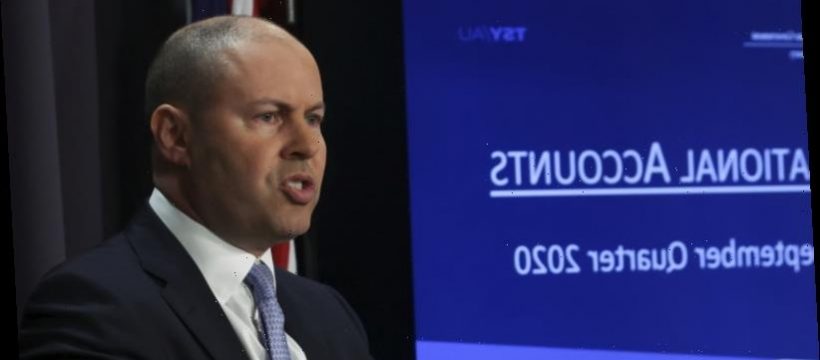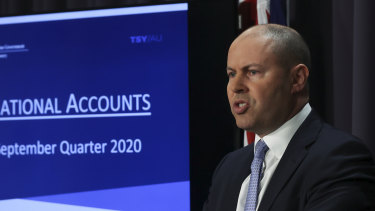The Australian economy is on track to fully recover from the pandemic recession by the middle of next year after figures revealed the largest quarterly expansion in GDP since the mid-1970s as consumers freed from coronavirus restrictions went on a spending spree.
Gross domestic product grew 3.3 per cent in the three months to the end of September, clawing back some of the June quarter's 7 per cent contraction as large parts of the economy were shut down.
Treasurer Josh Frydenberg says the figures are promising and show the economy is starting to grow.Credit:Alex Ellinghausen
The economy has not grown so much in a three-month period since the March quarter of 1976. Most of the expansion was due to household spending, which jumped by 7.9 per cent.
Consumer spending through hotels, cafes and restaurants, which had dropped by 56.5 per cent in the June quarter, soared back by 49.7 per cent in the September quarter. Spending on clothes and shoes increased by 21.8 per cent, on health services by 20 per cent and on transport services by 50.7 per cent.
Despite the surge in spending, consumer spending – which accounts for 60 per cent of economic activity – is still 7 per cent down on where it was before the coronavirus recession.
The overall economy is 4.2 per cent smaller than it was before the pandemic.
Consumers are also sitting on a large war chest of cash. The household savings ratio edged down from 22.1 per cent to 18.9 per cent, but is still the fifth-highest level on record.
Treasurer Josh Frydenberg, who claimed the quarterly result would have shown GDP up 5 per cent but for the second shutdown across Victoria, said the figures were promising and showed the economy was starting to grow.
"Technically, Australia's recession may be over, but Australia's economic recovery is not. There is a lot of ground to make up and many Australian households and many Australian businesses are doing it tough," he said.
The impact of the Victorian lockdown was most obvious in state final demand, which measures the domestic side of state and territory economies. Victorian state final demand is 9.8 per cent down on a year ago while in NSW it is down by 3.3 per cent.
The Treasury, Reserve Bank and the OECD in its global outlook released this week had been expecting the Australian economy to return to its pre-virus level early in 2022.
But the strong rebound in the September quarter, and signs the December quarter will also be strong due to the reopening of Victoria, is forcing a re-appraisal of those forecasts.
NAB chief economist Alan Oster said growth of around 2 per cent in the December quarter was likely as Victoria exited its lockdown.
"Additional gains in consumer spending, supported by the end of Victoria's lockdown, should support a healthy recovery in activity. As such, NAB forecasts GDP to have recovered pre-virus
levels by the end of 2021," he said.
The figures, however, did show ongoing weakness in business investment. Spending by private firms on buildings dropped 4.9 per cent to be 9.6 per cent lower over the year, while expenditure on plant and equipment is now 13 per cent lower than at the September quarter 2019.
Net exports sliced the overall result by 1.9 percentage points, with the country being hurt by the absence of foreign tourists and international students while the growing diplomatic dispute with China is hitting sales of Australian coal and wine.
Shadow treasurer Jim Chalmers said despite the economy now in recovery mode, for many people it would still feel like a recession.
"This quarterly GDP number will be cold comfort for a million Australians unemployed; cold comfort for the 2.4 million Australians who are either looking for work or looking for more hours at work," he said.
RBA governor Philip Lowe, giving evidence to a parliamentary committee, said there were positive signs for many parts of the economy, which was expected to grow by 5 per cent in 2021 and 4 per cent in 2022.
But he warned the recovery would be bumpy, with unemployment likely to remain above 6 per cent for an extended period.
"What has become clearer, though, as time has passed is that Australia is likely to experience a run of years with unemployment too high and wage increases and inflation too low," he said.
Australian Council of Social Service chief executive Cassandra Goldie said while some pundits were marking the end of the recession, it was a different story for those without a job and reliant on government support.
"We are still in recession as long as we have high levels of unemployment. We are still in recession while less than half the full-time jobs lost have been replaced. At this stage, we've only regained one-third of them," she said.
Most Viewed in Politics
Source: Read Full Article

